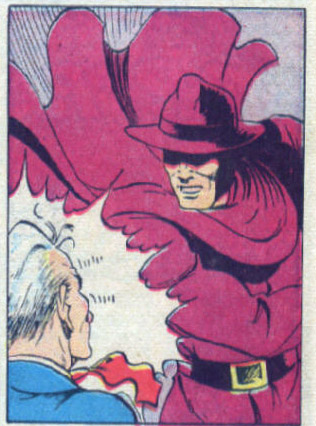711 + Destiny
Created by George Brenner
711

NAME + ALIASES:
Daniel Dyce
KNOWN RELATIVES:
None
GROUP AFFILIATIONS:
None
FIRST APPEARANCE:
Police Comics #1 (August 1941)
APPEARANCES:
- Police Comics #1–15 (August 1941–January 1943)
NAME + ALIASES:
Unrevealed
KNOWN RELATIVES:
None
GROUP AFFILIATIONS:
None
FIRST APPEARANCE:
Police Comics #15 (January 1943)
APPEARANCES:
- Police Comics #15-36 (January 1943–November 1944)
SEE ALSO:
Destiny

711 and his successor Destiny, were created by George Brenner. Brenner served as editor of Quality Comics for many years and was close personal friends with Busy Arnold too. 711 bears a strong resemblance to the popular Shadow; both wore a hat and cloak/cape, their faces shadowed by their hats. Together 711 and Destiny ran for three years in Police Comics. Brenner “killed” 711 just before he became an editor at Quality. Both characters’ backstories were fairly interesting, even if their adventures were not.



711
Daniel Dyce was a promising young attorney—and a gullible one at that. His friend Jake Horn convinced Dyce to take a rap for him, on account of the impending birth of Horn’s child. But after Dyce was convicted and sent to prison as “Horn”, the real Horn was killed in an accident and Daniel was left with no way of proving his innocence. Now known merely as convict #711, Dyce spent two years secretly digging a tunnel out of Westmoor Prison. During that time Dyce concluded that his life on the “outside” was now dead, and so he chose to remain in the prison, but fight crime as “711” in public. Dyce wore a crimson jacket and cape and a hat which cast a heavy shadow over his face. (Police #1)
…
[ Read
the full profile in the Quality Companion ]
Destiny
In his first appearance (Police #15), Destiny was a mere silhouette. The text teased: “see Destiny in the background—that daring new character—who starts in where 711 left off.” Destiny was an unnamed, non-costumed character who wore a plain brown suit and hat.
Destiny’s first case began as he—a solitary, pathetic figure—wandered the rainy streets in search of shelter. He entered a club where the Professor Seezall Nozal was performing his tricks of the mind. Nozal plucked our hero from the audience and instantly sensed that the young man was special. The Professor declared that he had the power to foresee death and that he could choose to use that power for good or evil—“you are Destiny!” The young man left the club before learning more from Nozall. Soon Destiny discovered that when he focused his mind, he would be transported to the scene of impending death. The first time his powers were activated, Destiny’s path crossed with 711’s killer, Oscar Jones. Jones escaped and Destiny lingered to speak to the spirit of 711, who wished him luck. (#16)
[ … Q. C. ]
Notes
Bat-fan trivia: in the 711 story in Police #4, Daniel Dyce learned of a plot to “snatch the Van Dern pearls.” Van Dern is the name of Batman’s maternal family, and pearls are a symbol linked to his mother’s death (modern revelations).
The significance of 711’s name is likely rooted in gambling. Seven and eleven are winning numbers in craps. “711” was also the name of the gambling club in the very first Lady Luck story.
Destiny was the inspiration for a character (in name only) in John Arcudi’s 2002 Elseworlds series, JLA: Destiny. Arcudi’s character was a woman with precognitive powers.
Powers
711 had no special powers. He was an accomplished hand-to-hand combatant.
Destiny’s powers were innate, and unlocked by a mentalist. By concentrating and entering a trance state—“making his mind a blank”—Destiny was enveloped by a whirlwind and transported to the scene of some crime, trouble, or death. There seemed to be no limits to this power; he teleported as far as Poland, and it even worked subconsciously, transporting him in his sleep. The teleportation would only be triggered if the threat was real, and not staged.
Appearances + References